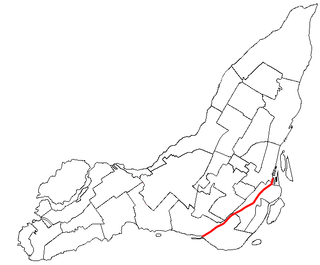
The Lachine Canal is a canal passing through the southwestern part of the Island of Montreal, Quebec, Canada, running 14.5 kilometres from the Old Port of Montreal to Lake Saint-Louis, through the boroughs of Lachine, Lasalle and Sud-Ouest.

Jeanne-Le Ber was a federal electoral district in Quebec, Canada, that was represented in the House of Commons of Canada from 2004 to 2015. Its population in 2006 was 112,863. It was abolished for the 2015 election and dissolved into Ville-Marie—Le Sud-Ouest—Île-des-Sœurs and LaSalle—Émard—Verdun.

LaSalle is the most southerly borough (arrondissement) of the city of Montreal, Quebec, Canada. It is located in the south-west portion of the Island of Montreal, along the Saint Lawrence River. Prior to 2002, it was a separate municipality that had been incorporated in 1912.

Verdun is a borough (arrondissement) of the city of Montreal, Quebec, located in the southeastern part of the island.
Pointe-Saint-Charles is a neighbourhood in the borough of Le Sud-Ouest in the city of Montreal, Quebec, Canada. Historically a working-class area, the creation of many new housing units, the recycling of industrial buildings into business incubators, lofts, and condos, the 2002 re-opening of the canal as a recreation and tourism area, the improvement of public spaces, and heritage enhancement have all helped transform the neighbourhood and attract new residents. Community groups continue to be pro-active in areas related to the fight against poverty and the improvement of living conditions.

Griffintown is a historic neighbourhood of Montreal, Quebec, southwest of downtown. The area existed as a functional neighbourhood from the 1820s until the 1960s and was mainly populated by Irish immigrants and their descendants. Mostly depopulated since then, the neighbourhood has been undergoing redevelopment since the early 2010s.

Ville-Marie is the name of a borough (arrondissement) in the centre of Montreal, Quebec. The borough is named after Fort Ville-Marie, the French settlement that would later become Montreal, which was located within the present-day borough. Old Montreal is a National Historic Site of Canada.

Saint-Henri is a neighbourhood in southwestern Montreal, Quebec, Canada, in the borough of Le Sud-Ouest.
Ville-Émard is a neighbourhood located in the Sud-Ouest borough of Montreal, Quebec, Canada.
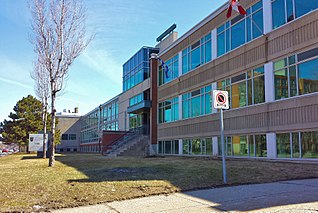
The Centre de services scolaire Marguerite-Bourgeoys is an autonomous school service centre on Montreal Island, Quebec, Canada, appointed by the Ministry of Education.
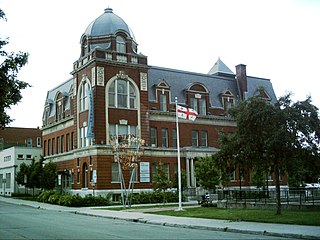
Little Burgundy is a neighbourhood in the South West borough of the city of Montreal, Quebec, Canada.

Atwater Avenue is a major north–south street located in Montreal, Quebec, Canada. It links Doctor Penfield Avenue in the Ville-Marie borough to the north, and Henri Duhamel Street in the Verdun borough to the south. It is named for Edwin Atwater. The street runs through the Atwater Tunnel near the Atwater Market in Saint-Henri, before climbing and straddling the border of the city of Westmount.
The Canal de l'Aqueduc is an open-air aqueduct canal on the Island of Montreal in Quebec, Canada, serving part of the drinking water needs of the city of Montreal.

Côte-Saint-Paul is a neighbourhood located in the Southwest Borough of Montreal, Quebec, Canada.
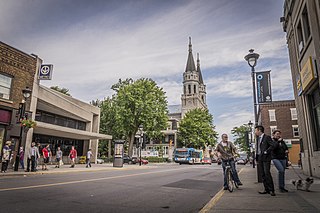
Wellington Street is an north–south thoroughfare located in Montreal, Quebec, Canada. It starts at LaSalle Boulevard in the borough of Verdun, passes through Pointe-Saint-Charles and Griffintown in the borough of Le Sud-Ouest, and terminates at McGill Street in Old Montreal in the borough of Ville-Marie. Wellington Street spans 5.7 km (3.5 mi) in length.
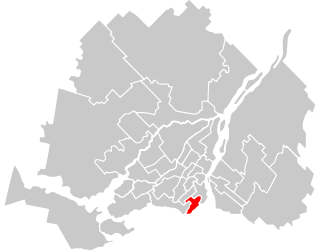
LaSalle—Émard—Verdun is a federal electoral district in Montreal, Quebec. It was created by the 2012 federal electoral boundaries redistribution and was legally defined in the 2013 representation order. It came into effect upon the call of the 42nd Canadian federal election, scheduled for 19 October 2015. It was created out of parts of Jeanne-Le Ber (51%) and LaSalle—Émard (49%) plus a small section of territory between the Lachine Canal and the Le Sud-Ouest borough boundary taken from Westmount—Ville-Marie and an adjacent uninhabited section from Notre-Dame-de-Grâce—Lachine.

Saint Patrick Street is a street in Montreal, Quebec, Canada.






















